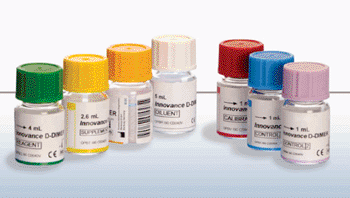Postoperative Biomarker Found for Venous Thromboembolism
By LabMedica International staff writers
Posted on 20 Aug 2013
The D-dimer test is often used to rule out the presence of venous thromboembolism, but the test has been considered unreliable in postoperative patients because D-dimer levels may rise after surgery.Posted on 20 Aug 2013
The presence of deep vein thrombosis (DVT) or pulmonary embolism (PE), both manifestations of venous thromboembolism, can be detected by performing the D-dimer test. D-dimer is a fibrin degradation product, which is produced when a blood clot or thrombus dissolves.

Image: INNOVANCE D-dimer assay (Photo courtesy of Siemens).
Scientists at the University of Halle (Germany) conducted a single-center prospective study between April 2010 and February 2012 in patients undergoing elective surgery that involved craniotomy. The study sample consisted of 59 female and 42 male patients ranging in age from 18 to 82 years. Doppler ultrasonography was used to directly detect the presence of thrombus in the patient's lower extremities. If DVT was identified, the location of this disorder was also noted to determine the associated risk of PE.
Plasma levels of D-dimer in all patients were evaluated preoperatively and on the 3rd, 7th, and 10th days postoperatively with the INNOVANCE D-dimer assay (Siemens; Erlangen, Germany). The investigators found that a D-dimer threshold of 2 mg/L indicated venous thromboembolism with a sensitivity of 95.3%, a specificity of 74.1%, a negative predictive value of 95.6%, and a positive predictive value of 73.2%. Only two patients with venous thromboembolism had D-dimer levels lower than 2 mg/L. The D-dimer threshold for PE would appear to be even higher; in this small group of nine patients the mean D-dimer level was 7.14 mg/L.
The authors concluded that using a threshold of 2 mg/L, D-dimer levels will indicate venous thromboembolism in patients after craniotomy with high sensitivity and specificity. Pulmonary embolism seems to be indicated by even higher D-dimer levels. Julian Prell, MD, the lead author, said, “We were honestly surprised by the clarity of our own results, which strongly contradict the established doctrine. Before this study, D-dimer plasma levels were considered to be completely unreliable in the postoperative period. Now, screening for venous thromboembolism using D-dimer plasma levels appears to be very straightforward and clinically applicable.” The study was published on August 6, 2013, in the Journal of Neurosurgery.
Related Links:
University of Halle
Siemens














